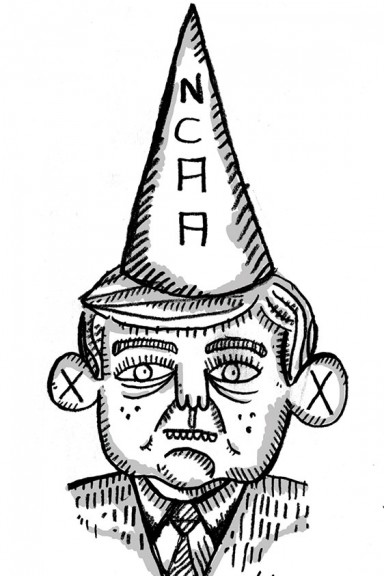

The Mark Emmert Hypocrisy Tour made a pit stop at Temple on Wednesday.
On Nov. 8, the National Collegiate Athletic Association hosted one of its many “Huddle[s] with NCAA President Mark Emmert” at Temple’s own Liacouras Center, wherein Emmert gathered 150 student-athletes, to spout – rightfully – that student-athletes must pay more attention to their grades, especially in light of increased eligibility standards set to take effect on Aug. 1, 2016. Among other things, the president reportedly discussed the NCAA’s ongoing legal battle over the use of player likenesses in video games, the morality of student-athlete merchandise sales and the fact that Division I athletes will most likely never see a direct cut of the billions they help bring the NCAA and its schools in television contract revenue each year.
“Dr. Emmert’s visit to Philadelphia was at the invitation of the Greater Philadelphia Chamber of Commerce to speak on the topic of college readiness and academic success,” Stacey Osburn, the director of public and media relations for the NCAA, said in an email. Osburn added that Emmert has held student-athlete “Huddles” at Whittier College, Old Dominion University and Marquette University, and that Emmert would spend some time at the University of Houston this week.
Taken in a vacuum, Emmert should, of course, spend as much time speaking to his constituents as humanly possible. Emmert, 60, was selected to succeed the late Myles Brand by the NCAA’s Board of Directors in 2010 and controls the fate of roughly 1,100 athletic departments nationwide.
However, Mark Emmert is potentially the most despised man in sports right now, and for good reason.
Emmert has the unfortunate distinction of being simultaneously the unluckiest and most ineffective man to ever lead the NCAA. Unlike Brand, who has been retroactively lauded for strengthening the association’s academic standards and cracking down on racially insensitive mascots, Emmert ascended to the presidency a mere 10 months before being rocked by the worst series of scandals in NCAA history.
Depending on who you ask, he’s been both far too lax and way too harsh on Pennsylvania State University’s football team after allegations broke in 2011 that former defensive coordinator Jerry Sandusky had been using his position to systematically rape young boys in on-campus showers for a decade and a half. Emmert and his team fined the university $60 million, cut many of the university’s available scholarships and banned the Nittany Lions from postseason play for four years.
After receiving massive blowback from both Penn State fans and the national media – an online ESPN poll in July found that 63 percent of the poll’s 30,000 responders were in favor of lightening or lifting the sanctions – Emmert waffled, agreeing to restore many of the university’s scholarships and to potentially lift the Nittany Lions’ postseason ban.
Emmert has also overseen a botched investigation of the University of Miami’s football team, wherein evidence that the university had given players millions in illegal benefits was illegally obtained, as well as the suspension of multiple high-level players for potentially violating the NCAA’s ludicrously strict policy that bars student-athlete from receiving any sort of outside compensation or gifts for their on-field performance.
This week alone, Emmert’s NCAA reinstated Colgate University freshman Nathan Harries after vacating his eligibility for allegedly playing against middle-aged men in three church league basketball games, according to Salt Lake City’s Deseret News. Moreover, Emmert and his cohorts are being sued for allowing video game publisher EA Sports to use player likenesses in video games while flatly refusing to let any NCAA student-athletes see a cut of the profits. According to NBC Sports, a federal judge cleared the suit on Nov. 8, allowing it to move forward in federal court.
This is the man that spoke to Temple’s student-athletes on Nov. 6.
Emmert took the time on Wednesday to remind Division I athletes that they aren’t going to be paid for their services any time soon, despite making $1.7 million himself in 2011 off of the backs of the very players he refuses to pay. According to the Chronicle of Higher Education, the NCAA signed a 14-year, $10.8 billion TV contract with CBS and Turner Broadcasting System in April 2010 to showcase basketball alone. Temple’s own American Athletic Conference has a television deal with ESPN through 2020.
For comparison purposes, the NHL’s latest 10-year TV deal with NBC Sports totaled a scant $2 billion according to USA Today, and that’s for an organization that pays the employees it concusses. Since 2010, Emmert has remained steadfast in his belief that players are compensated well enough in scholarship money, despite the fact that the practice is more akin to Microsoft hypothetically paying its employees in stock options than it is a benevolent charity giving back to its community. The National College Players Association maintains that FBS football players and Division I men’s basketball players lose an average of $456,612 and $1,063,307 per year, respectively.
So yes, Mark Emmert technically spoke to Temple’s student-athletes on Wednesday. Whether he was listening is another story entirely.
Jerry Iannelli can be reached at jerryi@temple.edu or on Twitter @jerryiannelli.


Be the first to comment